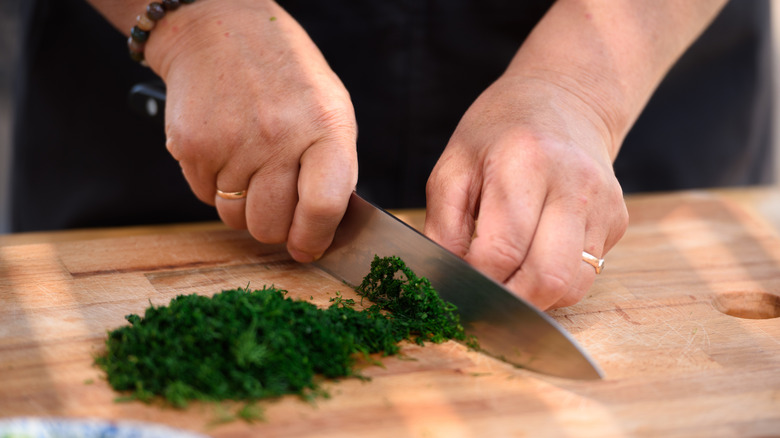Follow Gordon Ramsay's 3-Finger Rule To Chop Herbs Like A Pro
Most people make mistakes when cooking with herbs. Whether it is adding them at the wrong time in the cooking process or not washing them before adding them to your recipe, herbs come with their own unique set of challenges. But if you are using a fresh herb like chives or any of the delicate varieties, it is imperative to understand how to chop them if you want them to do their job. This is why Gordon Ramsay's three-finger rule is a must. What is it? It's a technique that comes down to how you hold your herbs with three fingers and position your knife for an effortless chop.
Why do you need to use it? Ramsay's trick will save your cutting board from turning green, and more importantly, it keeps the flavor of the herbs intact. The "Culinary Genius" host's method starts by positioning your middle finger in front of your index and ring fingers — one in front and two behind, gently clutching over the herbs. This allows the knuckle to protect your fingers — you never want your fingers vulnerable when a sharp blade is involved — while simultaneously guiding the knife. The end result is an herb that is finely chopped and has retained its flavorful superpower.
Make sure the blade is sharp
Furthermore, Gordon Ramsay explains that when you hold the knife, you want to lightly pinch it at the base. This, along with the three-finger rule, helps to reduce too much pressure from being exerted on whatever herbs you are chopping up. Why does it matter? If you are working with soft herbs like cilantro and basil, both of which bruise easily, you will find that, in addition to their appearance being less vibrant, and in many cases, turning black, they develop a bitter taste.
But before you start chopping up any herb, make certain you are starting with a sharp knife. A dull blade can cause you to press and tear your green flavor enhancers. A sharp knife, on the other hand, will allow you to do some of the basic knife cuts that will make you look like a pro chef, like the chiffonade. While you want to use a rocking motion for something like chives, when you chiffonade rolled basil leaves, you want to use a back-slicing technique. This method will produce ribbons of the herb that can be used for your cherry tomato, mozzarella, and basil salad.

